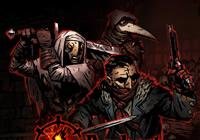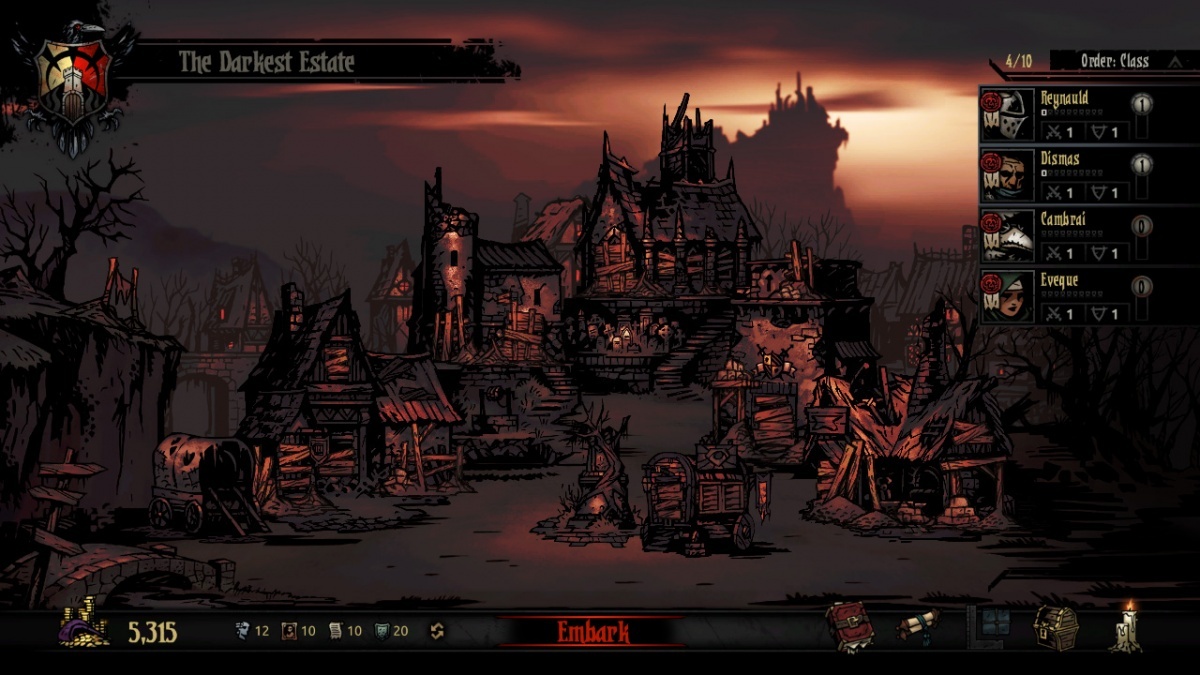Darkest Dungeon (Nintendo Switch) Review
By Renan Fontes  11.04.2018
11.04.2018

Originally released in January of 2016, Darkest Dungeon quickly made a name for itself as an incredibly difficult indie title that was equal parts RPG and management simulator. Dungeons featured the typical turn-based RPG fare, while the hub could be upgraded to make dungeoneering easier. At the same time, failing in a dungeon meant losing valuable resources and keeping the hub development at a standstill. Failure in one area typically meant failure in the other, and this made for a genuinely challenging experience. Red Hook Studios has now brought that challenge to the Nintendo Switch and, while it's still as difficult as ever, perhaps it's time to re-examine how Darkest Dungeon approaches challenge.
Darkest Dungeon is hard. It's doubtful anyone would ever deny that, but it isn't hard for the sake of being so. Rather, it's hard because it's punishing. Failure occurs most of the time, not due to overwhelming difficulty, but out of unpreparedness. This is an RPG, yes, but it's also an item, character, and town management simulator. Neglecting the latter will only make the former harder. Relying entirely on the RPG mainstays of levelling up ultimately leads nowhere. Careful character placements, financial knowhow, and patience are all larger keys to success.
Gameplay is effectively divided into two core sections: the Hamlet and the Dungeons. The Hamlet serves as the game's hub, where players are automatically sent to at the end of every quest. In the Hamlet, the Abbey and the Tavern relieve heroes of stress; the Blacksmith and Guild allow for heroes to upgrade their weapons or skills; the Sanitarium serves as a source for curing negative quirks or locking positive perks onto heroes; the Nomad Wagons sell equipment; the Survivalist teaches campfire skills to the heroes; and the Stage Coach acts as the main resource for recruiting new characters. The Hamlet is honestly overwhelming at first glance with an incredible amount of content to wade through.
The truth is that the Hamlet needs to be as busy as it is due to the sheer complexity of the gameplay. Characters suffer from stress, they need to upgrade their equipment and skills, they succumb to sickness, and they pick up quirks or perks all on their own. Without the Hamlet, all that's left is an offensively oppressive RPG. The Hamlet allows players to prepare their party for dungeon crawling. Only through proper preparation is success possible. Making good use of the Hamlet is easier said than done, though, as upgrading the various buildings requires an abundance of resources found within the dungeons.

Dungeon crawling will initially revolve around picking one of four areas to explore and then selecting an available quest associated with said area. While levelling up and acquiring new loot are certainly important, the main goal of dungeoneering is to complete the quests in order to obtain heirlooms. Busts, portraits, deeds, and crests can be found within the dungeons themselves, but they are also always a reward for questing. Although gold already serves as a type of currency, heirlooms act as another, specifically used for upgrading buildings. Without heirlooms, characters are locked to their default equipment and stress management becomes near impossible when exiting harder quests.
Stress as a mechanic is an interesting idea, and one that will end up punishing an unprepared party more than anything. Anything can trigger stress within a dungeon so it's important to always be cautious and patient in moving about or fighting enemies. Certain attacks can inflict a considerable amount of stress so logic would dictate killing enemies with that ability first; traps can catch party members off guard and the resulting damage can stress the party out; and interacting with an unsettling piece of the environment can stress the interactor, making it necessary to stop and think before examining piles of books or sacrificial altars. There's also a torch mechanic at play that constantly decreases. The darker the dungeon gets, the more stressed out the party becomes.
There are many ways a dungeon run can go wrong due to stress, but the Hamlet does offer everything a party needs to survive. Easy quests allow players to familiarise themselves with the four main dungeons without putting their party at risk: the Ruins require more food and torches than usual; the Ruins benefit from bringing along bandages and medicinal herbs; shovels, bandages, and anti-venom decrease the difficulty in the Weald considerably; medicinal herbs, shovels, and bandages keep the Cove manageable. Getting a feel for each dungeon is necessary, and can save a lot of gold since knowing what not to bring is just as important as knowing what to bring.

Party composition is likewise important, and having a rotation of multiple characters is less a piece of advice and more a core mechanic. The higher a character's level, the more reluctant they will be to take on easy quests. Only doing hard quests, however, will result in characters falling past their stress threshold and either disobeying orders in battle or raising the stress of the party themselves as they descend into madness. De-stressing a character typically takes an entire dungeon run, so it's good to have back-ups. More importantly, it's just good to have multiple teams that can take on easy dungeons to grind up gold as veteran party members recuperate in the Hamlet.
With 15 base classes to choose from, there's an incredible amount of party customisation available. Composing the right party for the right quest can be time consuming, but it's rewarding to build up a team and see them work together. Of course, party composition isn't just picking four compatible heroes; it involves positioning them appropriately since not every skill will work from every position. If a character has a skill that only works when they are in one of the three back rows, for instance, having them lead the party effectively removes one of their abilities. It's important to build a party with no blind spots.
Once a party has become fully upgraded, levelled up all the way to six, and decked out with proper equipment, it becomes time to tackle the titular Darkest Dungeon. While it remains on the dungeon screen from start to finish, a reminder of the inevitable end, facing it before truly understanding the mechanics and building up a suitable team is basically suicide. The Darkest Dungeon is demanding to the point where party members will refuse to go back in after one quest, meaning that building up only one party up to this point will mean starting afresh. If characters are going to die, they are going to die here. Party members who survive the Darkest Dungeon can still be used for other quests to grind for easy gold, but their journey is effectively over. It can be frustrating taking care of a team only to lose them at the effective endgame, but actually clearing the Darkest Dungeon is a reward unlike any other.

Even though the core gameplay is designed to be as punishing as it is, Red Hook Studios has made the right call in its inclusion of Radiant Mode. When doing a Radiant playthrough, heroes will be able to re-enter the Darkest Dungeon, albeit with severe side effects; the level restriction for dungeons is loosened; buildings require less heirlooms to upgrade and service costs are reduced; characters level up much faster; and unused provisions from dungeons give back more gold than in Darkest mode. In the options, players can also turn off some of the more demanding features for a less intense experience. It is worth noting, however, that the gameplay is not designed with Radiant Mode or the removal of core mechanics in mind. While the inclusion of these workarounds allow for anyone intimidated by the sheer difficulty to give it a chance they otherwise wouldn't, Darkest Dungeon is meant to be played on Darkest Mode with all the options left at their default.
On the subject of playing games as they were designed to, playing with a controller is far less intuitive than playing with a keyboard and mouse. This was a PC title initially, and it shows. To the porting team's credit, the Switch version does do everything it possibly can to keep the core experience intact. Just about every button on the controller has to be used as a result, which can lead to some awkwardness early on, but that hardly matters in the long run considering just how addictive the core gameplay is. It will never feel as natural as playing on the PC, but the Switch version is as good an alternative as many.
More importantly, everything that truly matters transitions as it should. The hostile atmosphere, the Lovecraftian aesthetic, and anxiety inducing soundtrack is all there. Darkest Dungeon is a fantastically produced RPG. Honestly, its sheer style may be its best quality. It offers some great gameplay and challenge, but its setting is so fully realised that it's hard not to feel immersed at times. Dungeon crawling can genuinely get scary, and it's all thanks to the production value. Darkest Dungeon isn't for everyone, but it's nothing short of a great game.

Cubed3 Rating
Great - Silver Award

Despite gameplay better suited for a mouse and keyboard, Darkest Dungeon transitions rather well from PC to Switch. The controls were always going to be convoluted when adapted to a controller, but it doesn't take too long to adjust, and the core gameplay loop is strong enough where overlooking that initial awkwardness is more than doable. The sheer challenge of the title will certainly overwhelm some, but there a plenty of workarounds between Radiant mode and the ability to toggle certain difficulty features off. The atmosphere, aesthetic, and music all lend themselves to an incredibly tense experience where every battle matters and constant management is necessary for survival. Darkest Dungeon is by no means for everyone, but that doesn't mean it isn't worth the stress.

![]() 8/10
8/10
![]() 0
(0 Votes)
0
(0 Votes)
 Out now
Out now  Out now
Out now  Out now
Out now  Out now
Out now Comments
Comments are currently disabled

 Sign In
Sign In Game Details
Game Details Subscribe to this topic
Subscribe to this topic Features
Features





 Top
Top

